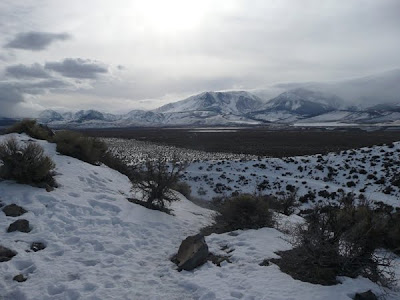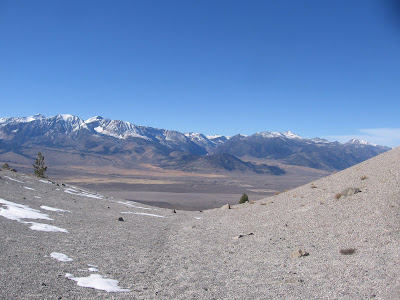
Wednesday, December 1, 2010
Saying Goodbye

Thursday, November 25, 2010
Why I'm Thankful

Tuesday, November 23, 2010
Moonlit Glides and First Turns


Sunday, November 21, 2010
A compliment
Thursday, November 18, 2010
Perspective


Monday, November 15, 2010
Hiking Barefoot
That said, I also love being able to escape to places where I can hike year-round, regardless of the weather at home. Death Valley is one of the places. I took a long weekend last weekend and headed South to visit the lowest point in the United States, at least that's what I thought I was visiting.
It turns out that Death Valley is MUCH more than just the lowest point in the United States. It's a series of mountain ranges with seemingly desolate valleys between, hot springs, beautiful slots canyons, glowing golden sand dunes, thunderstorms, endemic species, and a huge range of diversity that is very different from what my mountain upbringing had prepared me for. The days I spent in Death Valley were refreshing, educational and definitely enjoyable. Here is a sneak peak of what I did.
The first night I arrived after dark and set up my tent without really knowing where I was. I had arrived at the parking area for the Eureka Dunes, but I had no idea where they were, how big they were, or what they looked like. When I awoke the next morning, this is the view I had out of my tent:
I spent the morning exploring the dunes - trekking up the steep ascents as waves of sand cascaded down and between my toes (I learned early on that it's actually much easier to hike barefoot) and slide/skiing down in mini avalanches. I watched little beetles paddling their way through the great sea of sand and leaving little scuttle-mark trails behind them.
I saw the individual grains dance when the wind kicked up. But above all, my favorite thing was the play of light on the ridges of the dunes. I began hiking around 8 am so the sun was still pretty low in the east and I got to see every little impression highlighted and cast in shadow as the sun moved across the sky. It was incredibly beautiful.
Scotty's Castle is pretty bizarre. A narrow highway winds through a desert canyon and suddenly opens onto the Scotty's Castle grounds - palm trees, a small stream and a castle that looks like it came straight off an Italian vineyard. It was built by a millionaire for his friend and Death Valley prospector Scotty Johnson in the 1930's. It's a beautiful castle but seems somehow out of place in the desolation of Death Valley.
Ubehebe Crater is equally bizarre. The road takes you right to the rim of the crater and there in front of you is a 700 foot hole, as though someone has taken a gigantic ice cream scoop out of the earth. It is vibrantly colored in orange striations and is of volcanic origin.
The next morning I headed back north and into the Grapevine Mountains. I hiked up and around a large alluvial fan and into Fall Canyon, one of the most beautiful slot canyons I've seen. The path was paved with small round rocks and the walls were striated and colorful.
I was completely alone and the only sound I could hear was the occasional plane flying overhead. The difference between a Death Valley slot canyon and a slot canyon in Southern Utah is that the canyons in Death Valley are actually in mountain ranges. This means that they're really steep. In Utah the canyons are a lot more gentle so that even though you are hiking uphill, it feels relatively flat. Fall Canyon was steep and the loose gravel of the trail made for quite the calf workout. A couple miles us the canyon you run into the fall - basically a wall of smooth marble that is about 18 feet tall. I brought my climbing shoes, but did not feel comfortable climbing without a spotter; this was the end of my hike.
That evening I went to Salt Creek, a sink in Death Valley proper that is about 262 feet below sea level, only about 20 feet higher than the lowest point in the US. Salt Creek is cool because it is entirely colonized by a plant called pickleweed that has special salt and heat resistant adaptation.
Salt Creek is also home to the endemic Death Valley pupfish. It's hard to imagine anything living in the hyper-saline water of Salt Creek that recedes to almost nothing in the summertime. Nonetheless, these pupfish persist year after year in the little water available in such a harsh environment. Unfortunately, I didn't get to see any pupfish because they had all followed the water upstream to little pools that remain even in the heat of summer. I did, however, get to see Salt Creek begin it's annual rewatering. Both nights that I camped in Stovepipe Wells it rained which was enough to get Salt Creek flowing back downstream. I was there right at sunset and it was incredibly beautiful.
It was amazing in the rain because the moisture brought out even deeper colors in the rock. This canyon also had a fall - about 30 feet tall this time - but the trail bypassed it through a series of climbs and traverses on the canyon wall. It was a very satisfying hike and I think the narrows in this canyon were the best I've seen.
On the way home I made a stop at Darwin Falls, a total anomaly in the midst of the dry desert scrub and sand. Darwin Falls is set a couple miles back in Darwin Canyon and is absolutely unexpected. The hike takes you up a gravel strewn wash among mesquite trees and russian thistle, but suddenly you come around a corner and there are willows and cottonwoods. Hike a little farther and you can see ferns and other water plants growing right in the little creek. The trail winds back along a rock wall of a gorgeous little falls that empties into a small pool back in a creviced corner of the canyon. What a refreshing way to end a weekend in the desert!
Death Valley is strange. There's really no other word for it. It's not what you expect at all and ecologically speaking, it's more diverse than you can imagine. Inside the park, the elevation varies from -282 to over 11,000 feet. The country is incredibly wild and much of the park is under visited. These few days that I got to explore only whetted my appetite for many future Death Valley trips.
Friday, October 1, 2010
More visitors!




Friday, September 24, 2010
Big Changes

Tuesday, August 3, 2010
My parents came to visit!




Tuesday, July 13, 2010
Glass Mountain 7-12-10



Friday, July 2, 2010























